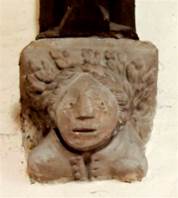Wild Men of the Middle Ages
If you look up in an old church the chances are that you will see some strange faces carved on the medieval stone corbels supporting the roof timbers. At Thurcaston, in Leicestershire, one of the corbels depicts the mysterious, mythical Green Man – a foliate head whose meaning is obscure but seems to suggest man in a state of nature, leaves being considered sinful in medieval times. In the opinion of the expert consulted by the recorders this Green Man, however, has the face of another mythical being – the Wild Man, described thus in Spenser’s Faerie Queen: ‘his wide mouth did gape / With huge great teeth like a tusked Bore’. The Wild Men were believed to inhabit forests and were uncivilised and savage.
The head wearing a leafy garland is that of a real man. He is garlanded for the celebration of May Day when the coming of summer was marked by games, dancing and, by implication, drinking and sexual debauchery. It was pointed out to the recorders that his unbuttoned shirt denotes his readiness for the wild times ahead!




